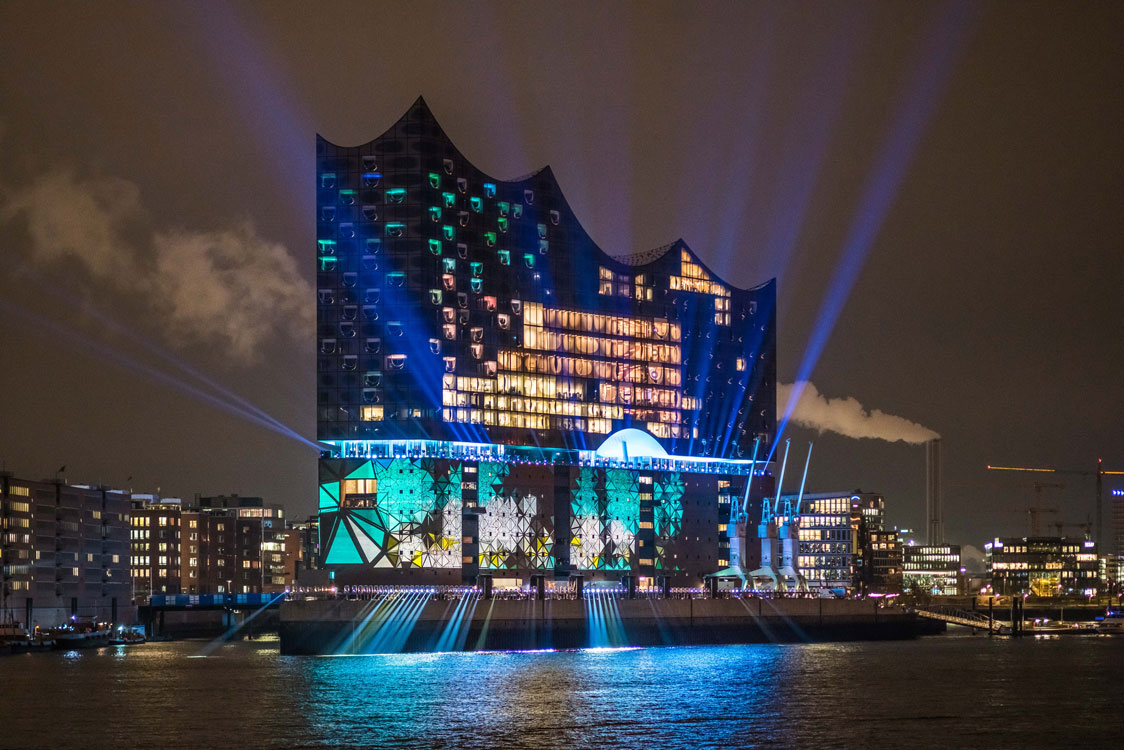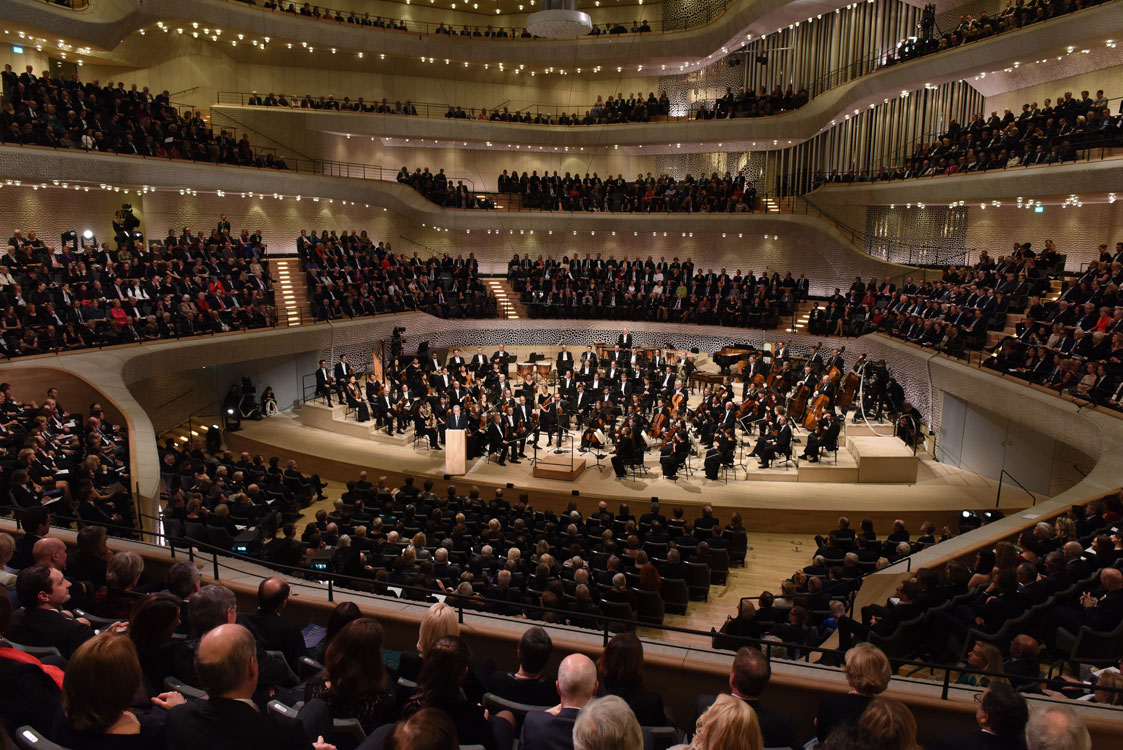Full report: Hamburg’s Elbphilharmonie opens at last
Andrew Mellor
Friday, January 13, 2017
The controversial and gargantuan project in Germany’s second largest city has finally hosted its first concerts, and Andrew Mellor was there for Gramophone

Berlin’s Brandenburg Airport and Stuttgart’s new underground railway station remain unfinished. But the third cursed construction project that was fast eroding Germany’s reputation for civic efficiency – the Elbphilharmonie in Hamburg – has opened at last.
There was a palpable sense of pride in the air as the concert venue and residential complex presented its inaugural concerts on Wednesday and Thursday. You could forgive the dignitaries and city officials present – including Germany’s Chancellor Angela Merkel – for having temporarily forgotten that the building arrived some seven years late and more than three times over budget, racking up a total bill of €789 million.
If anything can prompt sympathy for the individuals responsible for those missed targets, it is the Elbphilharmonie’s extraordinary design concept – perhaps the most ambitious, risky and decadent that the performing arts in Europe have ever seen. The glass, steel and concrete structure by Swiss practice Herzog & de Meuron sits on top of a building that had existed already for decades: a disused 12-storey cocoa warehouse dating from the 1960s.
The resulting edifice rises 110 meters above sea level at the tip of the Grasbrook peninsula on the River Elbe, surrounded by water on three sides. For the city-state of Hamburg, it’s the jewel in the crown of the emerging HafenCity (harbour city) district. Wolfgang Schmidt of the State Council of the Senate Chancellery of Hamburg, hopes it will be recognised as something far more: ‘We want it to become as much a symbol of Germany as the Brandenburg Gate is’, he says.

The centrepiece of the 200,000-ton structure is a concert hall that advances the asymmetrical ‘melting vineyard’ style seen in auditoria by Jean Nouvel and Zaha Hadid. The hall is lined with 200 square metres of plaster-coated gypsum, including 10% recycled paper. In its two-tone colour palette of off-white and deep grey, the auditorium feels cleaner than Jean Nouvel’s Philharmonie de Paris but cooler than his sensual Copenhagen Concert Hall. If anything, like LPR’s Musiikkitalo in Helsinki, the auditorium can feel a little too bright and cool.
The opening concert from Thomas Hengelbrock and the renamed NDR Elbphilharmonie Orchestra made up for that. The first half threaded itself seamlessly (and without applause) through eight works by composers including Britten, Zimmermann and Caccini, arriving at the celebratory Technicolor of the final movement from Messiaen’s Turangalîla Symphony. Highlights included Ensemble Praetorius’s stilling performance of their namesake composer’s Quam Pulchra Es from an upper balcony, and the NDR Orchestra’s rampant rendition of Liebermann’s thrilling Furioso.
After the interval, we heard the final movement of Beethoven’s Ninth Symphony with Byrn Terfel among the soloists, and the first performance of Wolfgang Rihm’s Reminiszenz – a song cycle for tenor, organ and orchestra sung by Pavol Breslik in which we also heard the hall’s new Klais organ under the fingers and feet of resident organist Iveta Apkalna (it was a shame not to hear at least one piece for organ alone).
Many in Hamburg, including the Elbphilharmonie’s General Intendant Christoph Lieben-Seutter, praised the hall’s superlative acoustics by Yasihusa Toyota. But at the opening concert, the hall could sound brash and unsympathetic, particularly when voices jostled with the orchestra. ‘The sound of the hall is the opposite to its looks’, the Hamburg-based critic and correspondent for Die Welt Peter Krause told me after the concert. ‘It has a sharp, crisp, extremely light and transparent sound that shows no mercy to the ears or to the minor errors even the best musicians in the world make. Every detail is presented perfectly, but never do the colours melt. Nothing is touching. It is a materialistic sound without any heart.’
Toyota’s acoustic designs in Copenhagen and Helsinki – particularly at the latter city’s Musiikkitalo – showed the same characteristics at first but warmed up over time. In Hamburg, the resident NDR Orchestra has already had a generous three-month bedding-in period.
Nor has the Elbphilharmonie entirely endeared itself to the citizens it looms over. ‘It was a story of failure and cost-explosion, and now it is a story of success’, says Wolfgang Schmidt. But that success has proved tricky in itself: with concerts sold out to keen subscribers for almost two years, the narrative on the street is that it’s simply impossible for the people of Hamburg, who paid for the building, to see a performance inside.
Lieben-Seutter has attempted to redress the balance by programming a dozen ‘concerts for Hamburg’ over the course of the coming year, each lasting an hour and offering tickets for as little as €6. That act has gone some way to satisfying demand and changing the narrative, but city officials couldn’t confirm whether the extra funding needed would be carried forward into future seasons, thus increasing capacity; ‘I don’t know’, admitted Wolfgang Schmidt when asked. The city has promised, however, that every school pupil will get to hear an orchestra play live in the Grand Hall.
That hall – one of three auditoria including an atmospheric chamber hall carved from oak and seating 550 – contains some fascinating and enchanting design details: curved ‘love seats’ like mini sofas present a beautiful solution to the natural bends in seat rows; the deeply upholstered single seats can be sat on before they’ve been folded down, making it easy to access seats even when others in your row are in position. Time will tell whether the gargantuan single escalator (the only escalator in the world that curves up and down as if scaling a hill) and three lifts will prove sufficient to carry 2,100 audience members up the twelve stories to the plaza and the concert hall’s ground floor, and back down again.
The entire Elbphilharmonie is visually breathtaking inside, outside and in between: a plaza between the brick warehouse and the glass structure is open to the elements and to the public and offers panoramic views of the city and the port (a hotel and apartment block are housed just above it, within the concert hall’s bowels).
But the building is also noticeably demonstrative given its surroundings in this north German city known for its restraint, and even for a certain tendency towards Scandinavian understatement. ‘There is something of Dubai-style architecture about it’, the architect and critic Koen van Synghel from Brussels told me; ‘It’s too much of a spectacle, and public architecture isn’t about spectacle.’ The assiduously deployed nickname ‘Elphi’ might go some way to making the building feel more down-to-earth and connected to the city that worked to hard to create it. But only time will tell if the Elbphilharmonie will become beloved of Hamburgers, let alone a concert hall fit for purpose.











